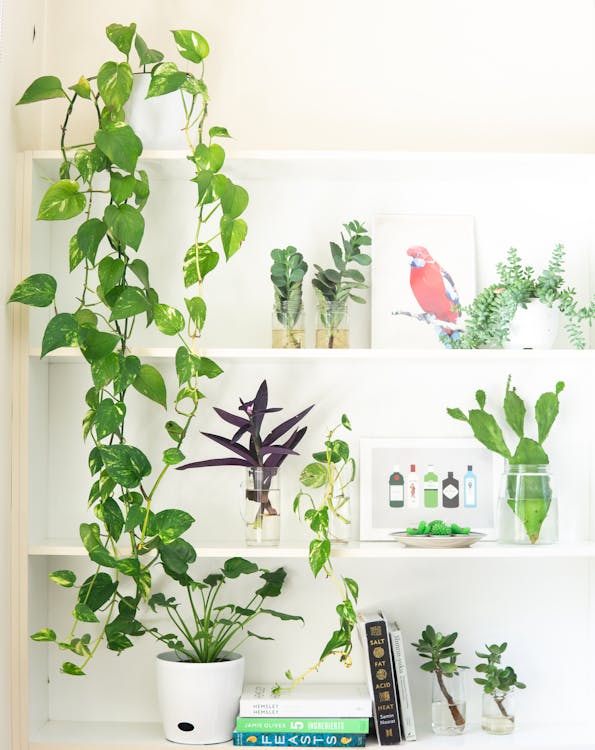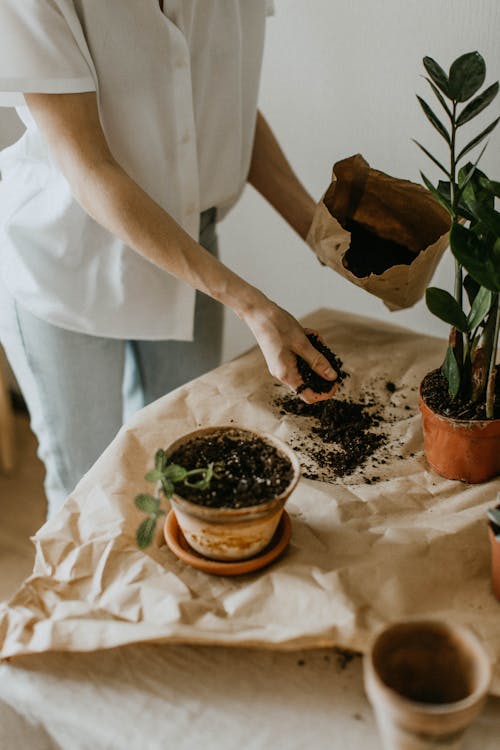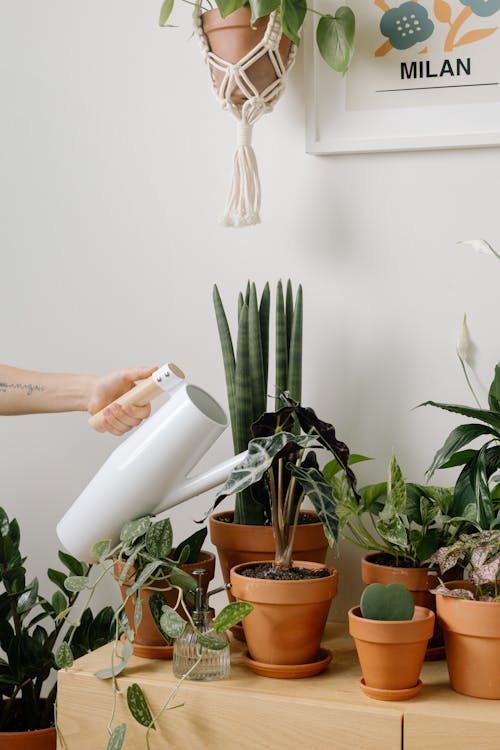As urbanization leads to more and more people flocking to small apartments in cities the popularity of houseplants continues to rise. In researching how to build and maintain our newly formed jungles, we sometimes fall prey to myths and misinterpretations of data. We've compiled some of the most common myths that plague the plant community. It’s time to debunk them!
Plant Myths:
1. You should always cut off yellow leaves
Removing brown and dying leaves from your plants is a must in order for the healthy foliage that remains to receive more nutrients. Yet, some confusion remains around how to handle yellow leaves. First instincts may tell us that the right thing to do would be to remove these the same way we would a dead or dying leaf. But this really isn’t necessary.

Yellow leaves can act as an indicator of a fixable problem, but they can also signal that a plant is doing well. This process is incredibly normal and natural in a plant’s life. Once a leaf has served its purpose, the plant removes most of the sugar and nutrients feeding that leaf and allocates them to other parts of the plant. This can result in a leaf turning from green to yellow. If the lowest leaf on a plant is yellowing, you’re probably in the clear. If a leaf is yellowing at the top of the plant, there may be an issue.
The most common problems that cause plants to develop yellow leaves include inadequate sunlight, underwatering or overwatering. It’s important during your plant parenthood journey to listen to what your plant is trying to tell you for the sake of its health and wellbeing.
2. Indoor plants must stay indoors
Before the houseplant category gained traction, all plants were thought of as “outdoor plants.” The main difference between indoor and outdoor plants comes down to the plant’s temperature tolerance. Indoor plants received their titles because of their low tolerance for cool temperatures, their long lifespan and their ability to thrive in containers.

Indoor plants, or houseplants, are generally species that thrive in temperatures between 60 to 80 degrees Fahrenheit. This means that many houseplants can actually benefit from trips outside during the Summer time in partially shaded areas. Many indoor plants are tropical, which means that the humidity and breeze that comes in the Summer season in some areas can be beneficial to helping them fight off fungal diseases and pests. Likewise, certain outdoor plants, such as some tomato species and herbs, can grow indoors by a south-facing window.
Even though there are differences between what is deemed an indoor versus an outdoor plant, the two categories are not mutually exclusive.
3. Plants shouldn’t be watered with tap water
It’s considered safer for humans to consume distilled water over tap water, so it makes sense to most of us that the same should go for what you water your plants with. Some resources suggest instead using distilled water; pure water that contains no minerals. While there are a few plants that prefer distilled water, the lack of minerals can actually be harmful to most. Plants require nutrients and minerals that tap water can give them.
Tap water is frequently described as containing harmful chlorine that is detrimental to a plant’s health. On the contrary, chlorine is actually an essential nutrient for plants. The small amount, if any, found in tap water is actually favorable for plants. Watering your plants with tap water can simply aid them in acquiring the nutrients that help them thrive.
4. Plants purify the air
There’s no denying that plants can and do absorb CO2 and other specific pollutants.
Our outdoor environment is improved from the presence and contributions of plants, so it only makes sense that they must have some effect on indoor environments.
In 1989, NASA conducted a study to determine if houseplants would help to filter or even add oxygen to the air on space stations, because letting some “fresh air” in by opening doors and windows wasn’t exactly plausible. They determined that certain plants were able to remove pollutants from the air, and to this day this study is often referenced in the houseplant community. However, the external validity for this experiment was low, as NASA’s findings were exclusive to a vacuum sealed space. And the modern person’s house is most definitely not a vacuum sealed space. The US Environmental Protection Agency reported in 1992 that in order to remove the amount of pollutants that NASA removed in their study, you would need 680 houseplants in a normal sized house, which is around 2,600 square feet.
Contrary to popular belief, NASA found after many tests that removing leaves from a plant actually improved a plant’s ability to remove pollutants from the air. This demonstrates that the microbes found in soil are more responsible and effective at purifying air than plants are!

Although plants have the ability to remove some harmful toxins from the air and produce oxygen, it is realistically nowhere near the level that could sustain and have large effects on the air purification of a human home.
5. You should be strict about your watering schedule
Watering on a schedule is a great way to fit plant care into our routines. However, plants can’t choose to abide by your schedule because every plant in every household is different.

Watering should be related to how often the soil that the pot is planted in needs water. This is determined by how quickly the soil dries out. The rate that soil dries out depends on many factors including the ingredients used in the soil itself, temperature, humidity, the amount of light the plant is getting, the size of the plant and the size of the pot. You can tell if you need to water the plant if the soil is dry by sticking your finger in it. If the soil is still wet then you can wait. As you get more comfortable and familiar with each of your specific plants, you can start to devise a flexible schedule.
6. Plants only need water and light to grow
Just like any other living thing, your plants need basic nutrients to grow and stay healthy. The main nutrient source your plants will feed off will come from the soil mix that you pot them in. That is why it is so important to pay attention to the soil you choose and the fertilizer that it contains.
Nitrogen, phosphorus and potassium are three major essential nutrients that plants need for growth. Although using a synthetic fertilizer is an easy and convenient choice to provide your plants with what they need, they come with a measurable cost to our planet. These fertilizers are derived from fossil fuels and contain man-made ingredients. There are many all natural fertilizers on the market with low impact, ethically sourced ingredients that contain all the necessary nutrients that your plant needs.
Indoor plants are living in a unique environment; that is, they’re living in a contained pot instead of a forest, jungle or desert set within a larger ecosystem. Because they don’t have access to the life and nutrients they would normally get from their surrounding environment, they’re dependent upon you to get nutrients and ensure their soil (and the microbiology in it!) is thriving. Feeding your plants helps prevent them from getting sick, stimulates growth and allows them to continue to put out new growth.
Sources:
https://www.gardenmyths.com/garden-myth-born-plants-dont-purify-air/
https://www.gardenmyths.com/air-purifying-plants-do-they-work/
https://www.alphaenvironmental.com.au/7-common-misconceptions-soil/
https://www.gardenmyths.com/indoor-plant-myths/
https://www.hunker.com/12189133/what-are-the-differences-between-indoor-plants-outdoor-plants
https://www.house-plant-hobbyist.com/blog/2018/9/4/fact-or-fiction-plant-myths
https://houseplantscorner.com/houseplants-guides/houseplants-need-distilled-water/
https://www.organicwithoutboundaries.bio/2018/10/31/synthetic-fertilizers/

